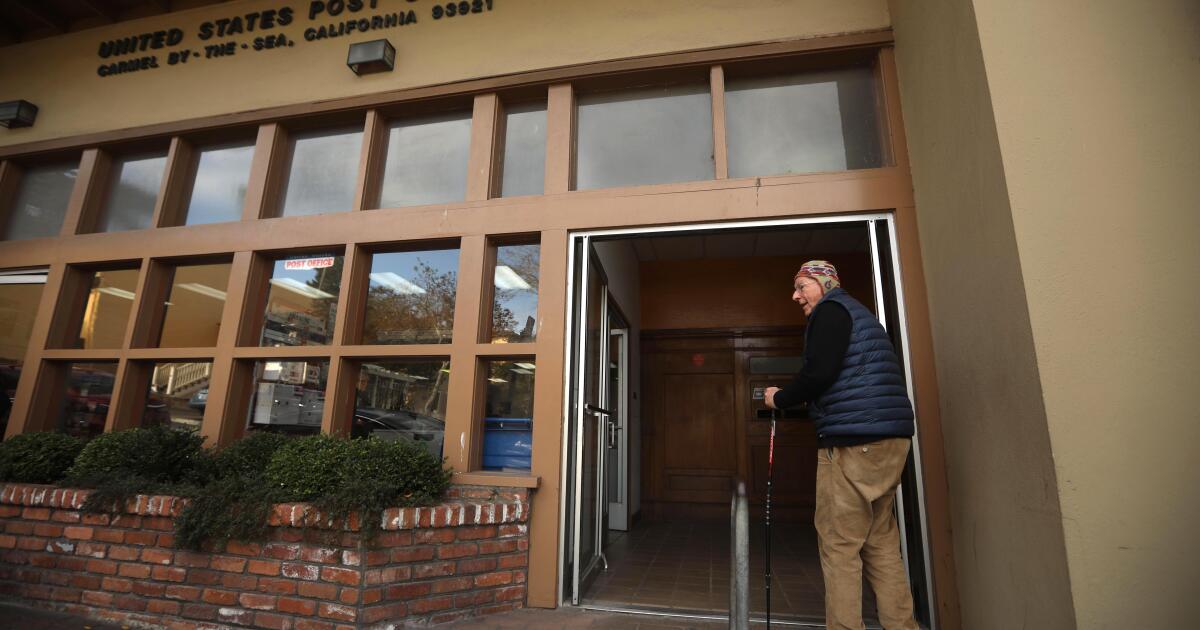Business
Carmel-by-the-Sea, a town with no addresses, says the time has come to add house numbers

After decades of resistance, Carmel-by-the-Sea is about to address some of its residents’ biggest frustrations.
Quite literally.
The moneyed little town, where homes and businesses have no street addresses, soon will have numbers assigned to its buildings, forgoing a cherished local tradition after too many complaints about lost packages, trouble setting up utilities and banking accounts, and other problems.
The Carmel-by-the-Sea City Council approved establishing street addresses in a 3-2 vote earlier this month, with proponents citing public safety concerns and the need to abide by the state fire code, which requires buildings to be numbered.
“Do we need to wait for someone to die in order to decide that this is the right thing to do? It is the law,” said Councilmember Karen Ferlito, who voted in favor of addresses.
Rather than street numbers, residents in the town of 3,200 have long used directional descriptors: City Hall is on the east side of Monte Verde Street between Ocean and 7th avenues. And they give their homes whimsical names such as Sea Castle, Somewhere and Faux Chateau.
There is no home mail delivery. Locals pick up their parcels at the downtown post office, where, many say, serendipitous run-ins with neighbors are an essential part of the small-town charm.
For more than 100 years, residents fought to keep it that way, once threatening to secede from California if addresses were imposed. They argued that the lack of house numbers — along with other quirks, such as no streetlights or sidewalks in residential areas — added to the vaunted “village character.”
“We are losing this place, day by day and week by week, from people who want to modernize us, who want to take us to a new level, when we want to stay where we are,” Neal Kruse, co-chair of the Carmel Preservation Assn., said during the July 9 City Council meeting at which addresses were approved.
Carol Oaks stands in front of her home, which is named “Somewhere” and has no formal address. Carmel-by-the-Sea will soon number its homes and businesses.
(Genaro Molina / Los Angeles Times)
The debate over street numbers has simmered for years and intensified during the COVID-19 pandemic, when people began shopping online more frequently and struggled to get their packages delivered.
Some residents and tourists worry that if they have an accident or a medical issue, emergency responders will have trouble finding them. Others have had trouble receiving mail-order prescriptions and medical equipment.
“This is a life-and-death situation in my life and my family,” resident Deanna Dickman told the City Council. “I want a street address that people can find on GPS and get there, and my wife can get the medication she needs.”
Dickman said her wife needs a shot that comes through the mail and must be refrigerated. If she can’t get it delivered, she has to travel to an infusion center and get her medication every 30 days “so she can breathe,” Dickman said.
Dickman once had her own temperature-controlled medication “tossed over a fence a block away.” The property owner was not home, and it spoiled.
Resident Susan Bjerre said she once needed oxygen delivered to her house for someone who had just gotten out of the hospital. The delivery driver could not find the residence, so she said: “I will be in the street. I will wave you down.”
“This is going to sound really snarky, but I think people who oppose instituting an address system don’t realize how inconsiderate they are to everyone else,” Bjerre said.
Another speaker, Alice Cory, said she worried that implementing addresses in Carmel-by-the-Sea — long a haven for artists, writers and poets — “would just make us another town along the coast.”
In the one-square-mile town, “the police know where everybody is,” and fire officials get to people quickly because there are so few streets, she said.
“Let’s keep it that way, and let’s keep the sweetness of this little town, because people know Carmel for a reason,” she said.

Neal Kruse, center, with Karyl Hall and her dog, Bubbles, chat with a resident at the Carmel Preservation Assn. booth at a farmers market. Kruse and Hall worry street addresses will hurt the town’s character.
(Genaro Molina / Los Angeles Times)
Emily Garay, a city administrative analyst, told the council that while local authorities might be familiar with Carmel-by-the-Sea’s unconventional navigational practices, other emergency responders — such as the California Department of Forestry and Fire Protection or Monterey County’s contracted ambulance provider — might struggle to quickly figure out where people live.
The California Fire Code requires buildings to have and display addresses. But Carmel-by-the-Sea has not enforced the provision.
“I believe, as a professional firefighter for over 37 years [with] a lot of experience in emergency response, that if the question is, ‘Is it more advantageous to have building numbers identified?’ Yes, absolutely,” Andrew Miller, chief of the Monterey Fire Department, told the council.
Residents opposed to street addresses have said they fear that numbering houses would lead to home mail delivery — which, in turn, could trigger the closure of the Carmel-by-the-Sea post office.
In January, David Rupert, a spokesman for the U.S. Postal Service told The Times that the post office had “been serving the local community since 1889” and there were no plans to close it. (The lobby for the post office was red-tagged this spring after a septuagenarian crashed her red Tesla through the front windows.)
Garay said addresses would not trigger home delivery.
Before voting against addresses, Mayor Dave Potter said he was “concerned about the fact that we’re kind of losing our character of our community along the way here” and that it had become the nature of the community “to fight over little things.”
But Ferlito said she had received “piles of emails from residents” who wanted addresses and worried about being found in a crisis.
“If we’re saying we will lose our quaintness because we have an address, I think that’s a false narrative,” she said. “This is more than quaintness. This is life emergencies.”

Business
Oracle CEO Safra Catz exits Disney's board of directors

Oracle Corp. Chief Executive Safra Catz will leave her position on the Walt Disney Co. board of directors Friday, the Burbank media and entertainment giant said.
Catz served as a member of the board for six years. After her departure, the board will have 11 directors instead of 12.
Disney Chief Executive Bob Iger described Catz’s contributions as “tremendous,” saying in a statement that she helped shape the company’s “long-term strategic planning amid a rapidly changing technological landscape that affects our businesses.”
“I’ve been honored to serve on Disney’s Board, and I am especially proud of the work we’ve done to fortify the company’s unparalleled strengths and continue its rich legacy of innovation,” Catz said in a statement.
Catz has served as CEO of software stalwart Oracle since 2014.
The move comes as Oracle co-founder and chairman of the board Larry Ellison has become more involved in the entertainment industry. His son, David Ellison, recently reached a deal to buy the Redstone family holding company National Amusements Inc., giving his Skydance Media control over Disney competitor Paramount Global. Larry Ellison is said to have contributed significant financing to the deal.
Business
Adidas cuts pro-Palestinian Bella Hadid from shoe campaign linked to deadly 1972 Olympics

Adidas has removed Bella Hadid from its social media pages after issuing an apology for “any upset or distress caused” by its release of an ad campaign for retro sneakers based on shoes first released during the 1972 Munich Olympics.
The company selected Hadid as the face of its SL72 project, which marks the 52nd anniversary of the Munich Olympics with a throwback to Adidas’ popular shoe from the 1970s.
In 1972, the Games were marred by the infamous Munich massacre, which happened after Palestinian militant group Black September orchestrated a terrorist attack targeting Israeli Olympic team members, nine of whom were taken hostage. By the time it was over, 11 Israelis, a West German police officer and five of the terrorists died.
The controversy follows the sportswear company’s decision to hire Hadid, who is Palestinian American and vocal about her advocacy for Palestinian relief efforts. Hadid, 27, has been posting her support for the Palestinian cause on social media for years. In 2017, the model spelled out her thoughts on Instagram.
“Watching the news and seeing the pain of the Palestinian people makes me cry for the many many generations of Palestine. Seeing the sadness of my father, cousins, and Palestinian family that are feeling for our Palestinian ancestors makes this even harder to write,” Hadid said. “The TREATMENT of the Palestinian people is unfair, one-sided and should not be tolerated. I stand with Palestine.”
Adidas faced criticism from Jewish organizations and Israel for aligning the SL72 campaign with a model known for her pro-Palestinian sentiments. The American Jewish Committee condemned Adidas’ decision, labeling it either a “massive oversight or intentionally inflammatory.”
“For Adidas to pick a vocal anti-Israel model to recall this dark Olympics is either a massive oversight or intentionally inflammatory. Neither is acceptable. We call on Adidas to address this egregious error,” the AJC said in a post on the social media platform X.
Adidas subsequently issued its apology.
“The adidas Originals SL72 campaign unites a broad range of partners to celebrate our lightweight running shoe, designed more than 50 years ago and worn in sport and culture around the world,” a spokesperson told The Times via email.
“We are conscious that connections have been made to tragic historical events — though these are completely unintentional — and we apologize for any upset or distress caused. As a result we are revising the remainder of the campaign. We believe in sport as a unifying force around the world and will continue our efforts to champion diversity and equality in everything we do.”
Representatives for Hadid were not reachable for comment Friday. A pinned post on the model’s Instagram account from 2021 underscores her commitment to raising awareness about Palestinian issues.
“A Palestinian girl on the cover of Vogue. The joy it brings me to say that….I won’t stop talking about the systematic oppression, pain and humility that Palestinians face on a regular basis. With only love in my heart and an open mind to educate myself and learn more every day…. No matter what.”
Business
What is CrowdStrike, and how did it cripple so many computers?

Talk about irony: The software that paralyzed Windows computers around the world late Thursday night and early Friday morning was planted by a company that protects Windows computers against malware.
That company is CrowdStrike, a publicly traded cybersecurity firm based in Austin, Texas. It acknowledged the problem around 11 p.m. Thursday and started working on a solution, offering a workaround in the wee hours Friday and a fix a few hours later.
The vast sea of Blue Screens of Death triggered by CrowdStrike’s error is a testament to the market-leading status of the company’s software, which detects and defends against malicious code planted by hackers. Its approach is known as “endpoint security” because it installs its defenses on devices that connect to the internet, such as computers and smartphones.
According to the website 6sense.com, CrowdStrike has more than 3,500 customers, which represent about one of every four companies buying endpoint security. Although most of its customers are based in the United States, it has hundreds in India, Europe and Australia, 6sense reports.
Here’s a quick explanation for how things went wrong so quickly for so many Windows users around the world, including airlines, hospitals, banks and government agencies.
The Falcon Sensor update
One of the selling points of CrowdStrike service is that it can improve its defenses rapidly as new threats are discovered. As part of that service, it continuously and automatically updates the Falcon Sensor software on its customers’ machines.
Automatic updates are, under normal circumstances, a good cybersecurity practice because they prevent clients from having machines with outdated defenses on their networks. But the latest incident reveals the flip side of the coin.
According to CrowdStrike, the problem was triggered by a “single content update” for its customers with Windows PCs. The buggy code wasn’t detected until after it had downloaded and installed on many of CrowdStrike’s clients machines.
Once loaded, the bad update interfered with core functions of the PC, causing Microsoft’s infamous blue error screen to pop up and convey a message along the lines of, “Your PC ran into a problem and needs to restart.” And as long as the update remained in place, restarting the machine led to the same errant result.
The fix offered by CrowdStrike
CrowdStrike stopped sending out the faulty update early Friday morning, so machines that had not loaded it yet were spared the turmoil.
For machines caught in the cycle of blue-screen hell, the company initially offered step-by-step instructions for how to reboot Windows in a mode that would allow them to find and delete the buggy update. The drawback, as many commenters online noted, is that this machine-by-machine approach isn’t much help for organizations with hundreds or thousands of bricked PCs.
According to the tech website 404, Microsoft also suggested rebooting a crashed machine multiple times — as many as 15 — could solve the problem.
Within a few hours, CrowdStrike was distributing a piece of software that removed the buggy code. This worked only for customers whose machines were able to connect to the internet and download the fix, though; everyone else would be left with the PC-by-PC workaround.
The lessons from the CrowdStrike debacle
Some Macintosh and Linux users, who were immune to the CrowdStrike-induced upheaval, devoted a portion of their morning Friday to spiking the football on Windows, even though the problem wasn’t caused by Microsoft.
Other observers argued that the incident demonstrated the risk of having one potential point of failure affecting millions of computers — a problem that has been demonstrated repeatedly during the broadband era.
Steve Garrison, founder of Stellar Cyber in San Francisco, said it’s more important to figure out how to make improvements than to play the blame game. This incident, he said, underscores the need for companies to spend plenty of time checking the quality of their products in a controlled environment before releasing them to customers.
Another lesson, he said, is the need for companies, their competitors and their customers to work together as a community to spot problems. “What do we need to do to check the checkers of our supply chain?” he asked.
Dan O’Dowd, a developer of security software for the military, said the fiasco demonstrates that we need better software in critical systems.
“The immense body of software developed using Silicon Valley’s ‘move fast and break things’ culture means that the software our lives depend on is riddled with defects and vulnerabilities,” O’Dowd said in a statement. “Defects in this software can result in a mass failure event even more serious than the one we have seen today.”
He added, “We must convince the CEOs and Boards of Directors of the companies that build the systems our lives depend on to rewrite their software so that it never fails and can’t be hacked. … These companies will not take cybersecurity seriously until the public demands it. And we must demand it now, before a major disaster strikes.”
-

 Politics1 week ago
Politics1 week agoProminent Dems cast doubt on Biden's claim he's staying in race
-

 News1 week ago
News1 week agoHow Democrats Will Choose a Nominee
-

 Politics1 week ago
Politics1 week agoWhat they're thinking: For many Democrats, silence speaks volumes on the Biden issue
-

 News1 week ago
News1 week agoShe was the target of an Iranian assassination plot. She now lives in its shadow
-

 World1 week ago
World1 week agoAfD and allies form new far-right group: Europe of Sovereign Nations
-

 World1 week ago
World1 week agoWill the NATO Washington summit deliver for Ukraine?
-

 Politics1 week ago
Politics1 week agoBiden's 'big boy' NATO news conference carries high stakes as first presser since disastrous debate
-

 Politics6 days ago
Politics6 days agoTwo key states to see massive GOP voter registration operation














